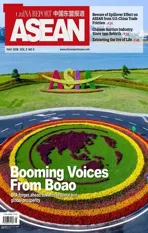BUSINESS & INDUSTRY
2018-06-07ByLiaoBowen
By Liao Bowen
The flagship project of China-Malaysia cooperation is twin industrial parks: China-Malaysia Qinzhou Industrial Park (CMQIP) in Qinzhou,Guangxi Zhuang Autonomous Region, China, and Malaysia-China Kuantan Industrial Park(MCKIP) in Kuantan, Pahang,Malaysia. This cooperation model (“two countries,twin parks”) features joint investment attraction, sales and management, providing an efficient way to complement each other’s strengths. The aim is to create Industrial Parks 4.0 in China, promote international industrial capacity cooperation and set a paradigm of China-ASEAN cooperation.
Amazing ‘Qinzhou Speed’
Qinzhou Industrial Park is expected to play a decisive role in the international cooperation of the Guangxi Zhuang Autonomous Region.
According to plans, the 55-square-kilometer industrial park will eventually feature a complex of an advanced manufacturing base, a platform for cooperation and exchange,a livable town of culture and a smart information corridor,hosting emerging industries such as food processing,bio-technology and modern services. Since its opening, the industrial park has enjoyed preferential policies and government support. “Qinzhou Speed” has become well-known in the industry.
In 2016, Qinzhou Industrial Park accelerated the construction of “industrial city projects.” By the beginning of 2018, it had attracted 91 such projects, with some already in the park and others still under negotiation. The total investment will be 88.3 billion yuan (US$13.5 billion), with an expected annual gross output value of 135.1 billion yuan(US$20.8 billion). The industrial park is being built in three phases. Phase I is expected to be completed by 2020.Opening ceremony of CMQIP Bird’s Nest Processing Trade Base on November 3,2017. The project is a pioneering step and proactive piece of the Belt and Road Initiative.
As a manufacturing base,the industrial park has already completed construction of the processing trade park. Construction on the entrepreneurial design park,the halal food industrial park and the education equipment production base has also started. As a livable town, the youth apartments and the resettlement apartments for local farmers are already in use. With construction on a series of industrial city projects including the international medical service industry cluster,a star-rated hotel and Peacock Bay Park, the industrial park is expected to become a town of emerging industries.
In March 2017, Tan Sri Ong Ka Ting, Malaysian Prime Minister’s Special Envoy to China and chairman of the Malaysia-China Business Council (MCBC), paid a visit to Qinzhou Industrial Park.Ong cited the twin industrial parks as fine examples of bilateral cooperation under the Belt and Road Initiative.With the help of the Malaysia-China Business Council,Malaysia-China Chamber of Commerce and other stakeholders, the Malaysian side will provide more assistance to the twin industrial parks in investment attraction and the introduction of more qualified enterprises. Ong opined that the “Qinzhou Speed” of the Qinzhou Industrial Park has
accelerated bilateral cooperation in the digital economy, crossborder commerce, culture and education.
Blazing “Qinzhou Speed”wouldn’t be possible without the efforts of the management committee. In July 2017, He Dang, a supervisor of the Economic Development Bureau of Qinzhou Industrial Park,revealed in an interview that when they first arrived at the site of the park, it was a savage land strewn with hills. The road network in the start-up area had not yet been completed. The garden engineering had not yet started. They had lunch and took breaks in a prefabricated house.“Now the park is completely different,” said He Dang. “As a Belt and Road Initiative project,construction of the basic infrastructure of the park has been completed. An increasing number of enterprises have entered the park. Meanwhile,the park has established a'capital-oriented' development model and constructed an industrial development platform for technologyfinance-manufacturing/modern services (TFM).” He Dang believes that the rapid development of the industrial park can be attributed to both the national policy framework and the support of local government departments.
The twin industrial parks represent a demonstration project of China-ASEAN cooperation, a trial zone for further reform and innovation and an important gateway on the 21st Century Maritime Silk Road. For Guangxi Zhuang Autonomous Region, it is an important platform and window to deepen opening up and cooperation with foreign countries, which will play an important part in promoting the economic and social development of the Region.
“The twin industrial parks have been planned and built as a major project of the Belt and Road Initiative,” said Tan Xiuhong,deputy director-general of the Department of Commerce of the Guangxi Zhuang Autonomous Region. “Cooperation between China and Malaysia on the twin parks will consolidate the foundation for building Guangxi into a new strategic pivot for the opening up of southwest and central-south China.”
Development Advantages

Qinzhou Free Trade Area Port in Guangxi Zhuang Autonomous Region.
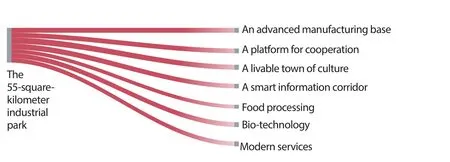
By the beginning of 2018, it had attracted 91 such projects, with some already in the park and others still under negotiation. The total investment will be 88.3 billion yuan (US$13.5 billion), with an expected annual gross output value of 135.1 billion yuan (US$20.8 billion). The industrial park is being built in three phases. Phase I is expected to be completed by 2020.
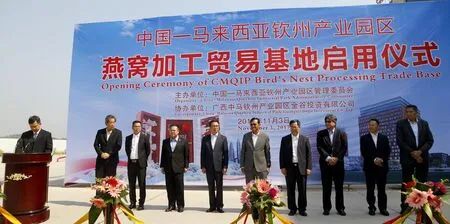
On May 15,2017, the China-Italy SMEs Cross-border Investment and Trade Conference is held in Beijing,China.
Qinzhou Industrial Park has made rapid progress in a short period of time due to advantages in geography,market and policy.
Qinzhou Industrial Park,near the favorably positioned Beibu Gulf provides access to a fast port transport system. It is situated at the intersection of a number of regional cooperation mechanisms such as the China-ASEAN Free Trade Area (CAFTA)and Pan-Beibu Gulf Economic Cooperation Zone.
Qinzhou Port is an important portal on China’s coast. Its current annual throughput capacity has reached over 100 million tons, with a planned future capacity of 500 million tons. Qinzhou Port has built an ocean direct route network covering the major ports of Southeast Asia, the Middle East, Africa, Europe and the Americas. It’s the most convenient port for trade between southwest and centralsouth China and Southeast Asian countries.
In terms of policy, alongside the privileges of the industrial parks, the two governments have provided investors special incentives, preferential policies and awards to attract foreign investment. Qinzhou Industrial Park enjoys specialized policy support and efficient services from the regional government,especially sufficient autonomy in major industrial layout,land, taxation, finance and other realms. Furthermore,leading enterprises with strong competitiveness and development potential will enjoy special offers tailored to meet their needs.
In terms of market, economic and trade cooperation between China and ASEAN is enjoying a period of rapid development.From 1991 to 2015, two-way trade between China and ASEAN grew at an annual rate of 18.5 percent, reaching US$472.16 billion in 2015 and accounting for 11.9 percent of China’s foreign trade, which is expected to reach US$1 trillion by 2020.
The developing countries of ASEAN also possess high quality raw materials for low prices and a high demand for hightech and high-tech products.Qinzhou Industrial Park will focus on six industries:food processing, equipment manufacturing, materials and new materials, biotechnology,electronic information and modern services.Biotechnology, material extracted from palm products,intelligent electronic devices and other high-tech products are expected to make up for the void in the ASEAN market.Palm Oil Boosts Cooperation
The China-Malaysia Grain and Oil Processing Project,based in Qinzhou Industrial Park, is a grain and oil processing plant focused on producing palm oil and blended oil. It was funded solely by the Guangxi Beibu Gulf Port Group.Construction started in July 2013 as one of the enterprises to first enter the industrial park and begin production.
The twin industrial parks represent a demonstration project of China-ASEAN cooperation, a trial zone for further reform and innovation and an important gateway on the 21st Century Maritime Silk Road.
Zhou Bo, deputy general manager of the Guangxi Gangqing Oil Company (project operator),explained the reasoning behind Guangxi Beibu Gulf Port Group’s choice to invest in this project.Thefirst reason is that the Group believes that the grain and oil industry has great potential in China.The second is the geographical proximity of Qinzhou Industrial Park to Qinzhou Port.The third reason is the experience the Group has accumulated in the industry after so many years of work.

1. A container truck with thefirst load of 378 SEIKI UHD intelligent television sets leaves Qinzhou Industrial Park for Qinzhou Port on January 15.
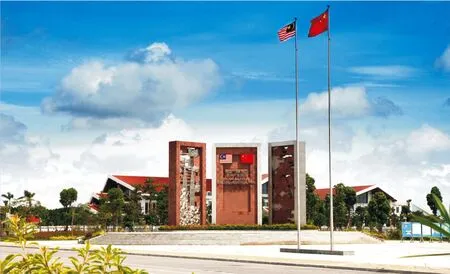
2. China-Malaysia Qinzhou Industrial Park.
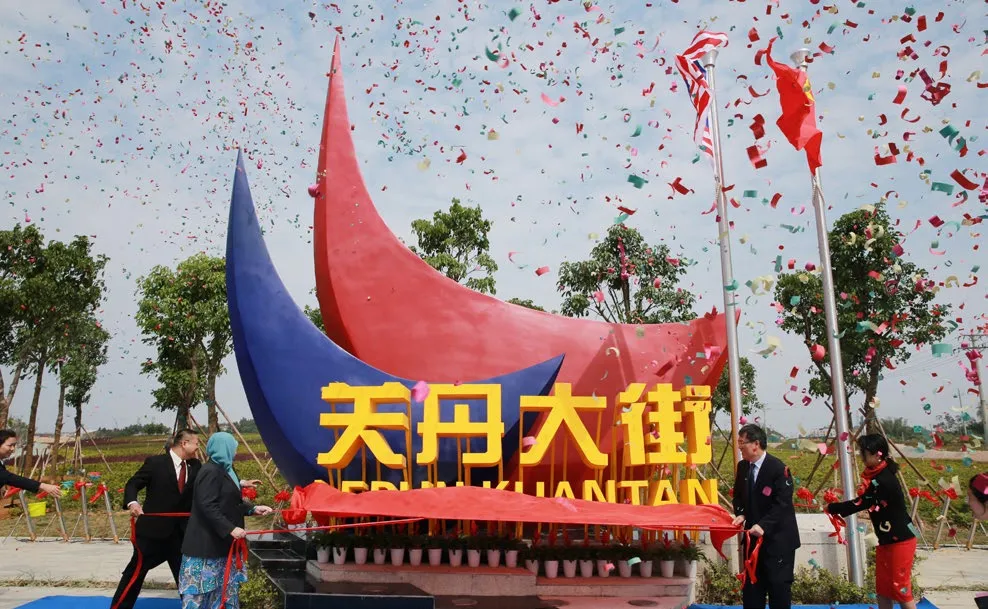
3. Officially opened on March 21, Kuantan Street in China-Malaysia Qinzhou Industrial Park is named after the Malaysian port of Kuantan, a sister-city of China’s Qinzhou.
According to preferential policies, the Guangxi Gangqing Oil Company received access to greater incentives and support including land pricing and tax concessions. “The most important factor was support in infrastructure construction,” said Zhou Bo. “The Industrial Park provided us with a lot of support,giving us a great advantage.”
Zhou Bo noted that his company’s current main business is soybean processing and palm oil processing. The company imports raw materials from abroad. Its products are sold mainly to southwest China. It has communicated with Chinese businesses in Malaysia to achieve market access. “Communication has been convenient and successful,” Zhou added.
Rich Seng Shin Too, a think tank member of the Department of Special Affairs of Malaysia’s Ministry of Communications and Multimedia, thinks that Chinese enterprises should have the courage and determination to venture away from the familiar domestic market and “go global.” Chinese enterprises should cultivate international vision and focus on brand in fluence and brand strategy instead of seeking short-term benefits, short-term cost recovery and pro fitability.
As a tropical country, Malaysia features plentiful palm groves.The country is the second largest palm exporter in the world.Ninety percent of its palm oil is exported. In October 2010,the Malaysian government launched a ten-year Economic Transformation Programme(ETP), which listed palm oil industry as one of the 12 National Key Economic Areas (NKEA).
In the long run, with the growing awareness of palm oil, increasing openness to national import controls and growing demand for palm oil,palm oil prices may rise in volatility. If Chinese enterprises can take full advantage of the geographical position of the twin industrial parks and the relevant preferential policies and upgrade the grain and oil project with more investment in research and development, they will likely benefit considerably from palm oil cooperation.
In recent years, the twin industrial parks have become the “ first stop” for Chinese companies and investors to invest overseas and enter the ASEAN market. For the foreign enterprises entering the Chinese market, the twin industrial parks have been a focal point.Weng Zhongyi, CEO of China-Malaysia Qinzhou Industrial Park Development Company,believes that the twin parks are a conduit for Chinese products to enter the overseas market.Meanwhile, his industrial park welcomes the investment and residence of enterprises from Malaysia and other ASEAN countries, which are competitive in traditional industries such as bird’s nests, halal food, rubber and palm oil deep processing.Resident enterprises will enjoy preferential policies in land,finance, taxation, human resources and many more areas.
With the upgrading of the ACFTA, implementation of the Belt and Road Initiative and deeper exchange between China and Malaysia across a wider range of fields, the twin industrial parks will enter a new stage of both opportunity and challenges.Governments on both sides have provided generous support for the project including synergized preferential policies, which have created a favorable environment for the twin industrial parks to achieve development in both quantity and quality. At the same time, they will have to seek alignment in development of other projects in Malaysia and other ASEAN countries.

